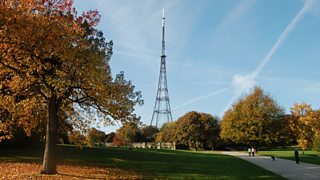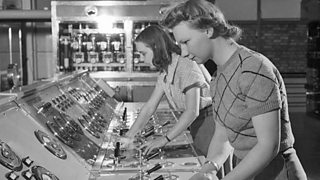
Crystal Palace Transmitter, South London
In the dark of the night of 23 to 24 October 2012, I flicked a switch at the , and the ΒιΆΉΤΌΕΔ's last remaining analogue terrestrial TV signal was switched off. The largest broadcast engineering project in history β digital switchover β is now complete.Μύ
The completion of digital switchover is important because it means that every television home in the country can now βaccess the UK Public Services that are intended for themβ as required by the .Μύ
It is also a significant moment in the history of UK television. When ; when the country stayed up late to see ; when the Sex Pistols swore at Bill Grundy β we were watching on analogue terrestrial TV.Μύ
You donβt survive for more than 80 years without being adaptable, and analogue terrestrial TV certainly went through a lot of changes in its lifetime.Μύ
When Baird Television Limited made its first broadcasts from Alexandra Palace in 1929, it used just 30 lines of resolution β enough to see a close-up of one personβs face. But when Μύ(now ΒιΆΉΤΌΕΔ One) launched in 1936, it was broadcast in βhigh-definitionβ. Of course, this was not quite HD as we understand it today, but it allowed people to watch drama, comedies, documentaries, game shows, and soap operas in their own homes for the first time.
It took the ΒιΆΉΤΌΕΔ a while to decide which system to use: for three months, it alternated weekly between Bairdβs 120-line, mainly mechanical system and Marconi-EMIβs all-electronic 405-line system. The latter won the day.Μύ

Women technical assistants operate a transmitter in 1965.
Over the decades, the number of available channels increased: ITV came along in 1955, followed by ΒιΆΉΤΌΕΔ Two in 1964; and S4C launched in 1982; and in 1997 Channel 5 was the final analogue terrestrial service to launch nationally (although a number of local βRSLβ stations began to appear from 1998).Μύ
After Channel 5 launched, there was no broadcast space (spectrum) left for any more national terrestrial channels, and viewers had to turn to satellite or cable TV if they wanted further choice. Then digital terrestrial TV arrived in 1998 and in 1999, the Government announced its intention for the UK to switch from analogue to digital terrestrial TV.Μύ Digital terrestrial TV allows viewers to receive far more channels β there are currently more than 50 TV channels and 25 radio stations on Freeview. And digital TV brings other benefits such as High Definition TV and interactive services. It also takes up less spectrum, creating space for local TV and services such as 4G mobile telephony and broadband.Μύ
The ΒιΆΉΤΌΕΔ was closely involved in digital switchover from the very beginning. This involved more than a decade of work. We collaborated closely with our technology and transmission providers to fundamentally change the way TV signals are carried across the airwaves.Μύ
In 2005, the people of the village of Ferryside in Carmarthenshire were the first in the UK to go fully digital. After this successful trial, switchover began in earnest. The first major transmitter to have its analogue signal turned off was in Whitehaven in 2007. One by one, the UKβs other transmitters were converted until, finally, we reached the end of our journey in Northern Ireland. All the while, we ensured that TV viewers and radio listeners could continue to receive ΒιΆΉΤΌΕΔ services despite the enormous disruption happening at the transmitters. Itβs a bit like turning a five-seater car into a coach, while driving 70mph down the motorway.Μύ
What was perhaps most remarkable about analogue TV was the amount of innovation that occurred over the years. From the adoption of the 625-line system and the arrival of colour TV in the 1960s, to the genesis of teletext in the 1970s (including the much-loved ΒιΆΉΤΌΕΔ service , which also came to an end with digital switchover), to the arrival of NICAM stereo broadcasts in the 1980s, broadcast engineers demonstrated their genius in pushing the technology forward, ensuring at each stage that older sets would not be adversely affected.
But although its analogue version is now gone, terrestrial TV continues to go from strength to strength.Μύ
Μύcelebrates its tenth anniversary on 30 October 2012. It has enjoyed a hugely successful decade, with c.20 million homes (thatβs four in five) now watching TV via Freeview and over half of them using Freeview as their sole TV platform. Like its analogue older sister, Freeview has kept pace with technical developments over the years: we have seen the launch of Freeview+ and Freeview HD, and there are projects in development to make sure Freeview remains competitive in the years to come.Μύ
Meanwhile, Μύhas now launched, seamlessly bringing together digital terrestrial TV and internet-delivered TV.Μύ
So while the analogue era has ended, the future of terrestrial broadcasting looks bright.
Μύ
Alix Pryde is Director, ΒιΆΉΤΌΕΔ Distribution
Μύ
As part of the digital switchover project, the ΒιΆΉΤΌΕΔ's teletext Ceefax service has been switched off. Steve Herrman writes about the end of the service over on . Paul Kerley from ΒιΆΉΤΌΕΔ News Online has also produced .Μύ
The
ΒιΆΉΤΌΕΔ played a leading role in setting up and funding . It also ran the , which installed digital TV equipment
for more than 1.3 million eligible older and disabled people and has been
completely run by the ΒιΆΉΤΌΕΔ.Μύ
